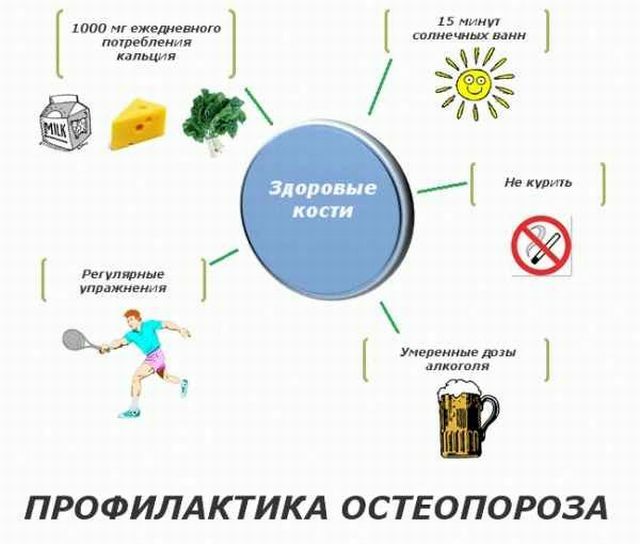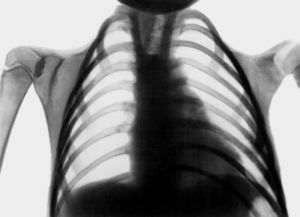 Cranio-clavicular diostosis( key-dysplasia dysplasia, Sheitheuer-Marie-Senton syndrome) is a disease that belongs to mixed forms of skeletal diseases.
Cranio-clavicular diostosis( key-dysplasia dysplasia, Sheitheuer-Marie-Senton syndrome) is a disease that belongs to mixed forms of skeletal diseases.
The problem is hereditary and is transmitted by an autosomal dominant type. The disease is characterized by complete or partial absence of the clavicle, as well as problems in the development of the bones of the skull.
Complete absence of clavicles in medical practice is rare enough - in 10% of cases. The most common pathology is manifested as the absence of part of the clavicle, the acromial section and the smaller scapula.
The cause of the development of the disease is the disorder occurring in one of the genes of the sixth chromosome.
Content
- article How it looks and appears
- Medical Assistance
- Dental care
- Surgery
- exercise therapy for the treatment and recovery
- Vitaminization
- Osteoporosis Prevention
How it looks and appears
First, cleidocranial dysostosis is characterized by changes in the collarbone, their underdevelopmentor complete absence of one.
With this disease a person can move the clavicles to each other in such a way that they can come in contact with each other.
Changes occur also in the structure of the skull: the cerebral part considerably enlarges and the facial part is reduced. Spring can not be closed for life.
In view of these external characteristics, the face turns out to be very small, and the forehead and the crown are very large. Given that this disease is genetic and sick to him usually by whole families, such people most often engaged in circus activities.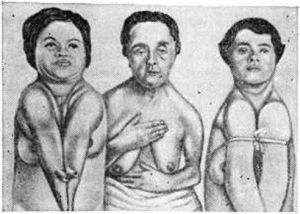
The upper jaw also undergoes changes: the hard palate is shortened, the jaw itself is underdeveloped, shortened in size. The development of permanent teeth may be belated: thus, milk teeth can last up to 25-30 years of age.
As a result of deformation of the clavicles, a jamming of the nerve plexus can be observed, which, in turn, can provoke muscle development and general weakness of the upper limbs.
But that's not all, a person with cranio-clavicular dysplasia can be:
- growth retardation;
- hypertelorism - excessively increased distance between paired organs( abnormally wide-set eyes);
- underdevelopment of pelvic bones;
- cleft palate( or arch-shaped palate);
- late teething;
- ultra-compact teeth, increased caries development;
- reduced thorax;
- kyphosis;
- osteosclerosis;
- scoliosis;
- as a result of reduced mineralization of bones their increased fragility is observed;
- in some cases deafness is possible;
- asymmetric finger length;
- brachycephaly - short-haired;
- mental retardation is not observed.
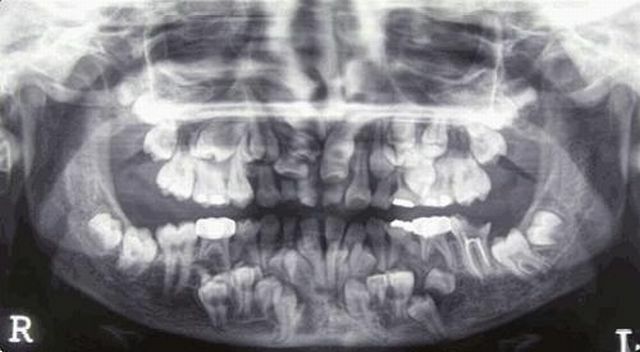
Dental series of a patient with a dysostosis
Immediately after the appearance of the baby on the light of the presence of the disease among other symptoms can say:
- at palpation the bones of the skull turn out to be soft;
- significantly increased the amplitude of movements( in the shoulder joints) due to the complete or partial absence of clavicles.
At the age of six or eight, patients with this disease require an X-ray examination, since there are no abnormalities in the osteoarticular system until this time.
At the age of six, the skull bones approach normal, while the pelvic bones acquire a more typical appearance for the disease.
Medical care
The medical care for this syndrome involves several stages.
Dental care
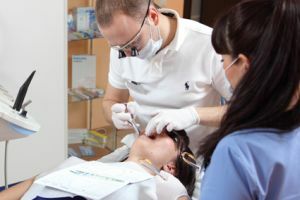 Klyuchichno cranial dysostosis - a disease that does not respond to treatment, so the work of doctors in this case is to combat the manifestations of the anomaly.
Klyuchichno cranial dysostosis - a disease that does not respond to treatment, so the work of doctors in this case is to combat the manifestations of the anomaly.
In childhood, the most significant is the problem of teething and further correction of their position. For this reason, patients with pathology must certainly consult an orthodontist who will help with the help of plates to put their teeth in their places.
Next, the work of dentists is to remove the milk teeth in time for a more comfortable and quick eruption of molars( if this does not happen naturally, the doctor exposes them artificially).
Operative intervention of
If collarbone is absent completely, surgical intervention is not appointed because of inexpediency. In such cases, only conservative treatment is possible.
If at least truncated fragments of bones are present, the operational method takes place. In this case, the operation to restore the clavicles will be actual.
Surgery is a very personal matter: if the patient( or parents of the patient) wants to solve the problem, the operation will be appointed, if not, the patient will be offered conservative treatment.
LFK for treatment and recovery
For patients with craniocerebral dysplasia, physical therapy is simply necessary, since weakened as a result of anomalies, the upper limbs need to be strengthened.
The movements and exercises should be completely painted according to the individual program, depending on the features of the course of the disease and those parts of the body that need to be worked out.
Vitaminization of
The intake of vitamins for patients is extremely important, especially for those involved in sports. Thus, the bone tissue and the whole organism is strengthened.
Since the immunity of people and this type of dysplasia is low enough, it must be constantly maintained by special medical preparations, as well as by hardening, especially for the prevention of colds.
Prevention of osteoporosis
From an early age, the patient is required in the prevention of osteoporosis. First of all, it is necessary to increase the intake of calcium and vitamin D in the body. Required to take sunbathing, and eating liver, sour cream, butter and sea fish.
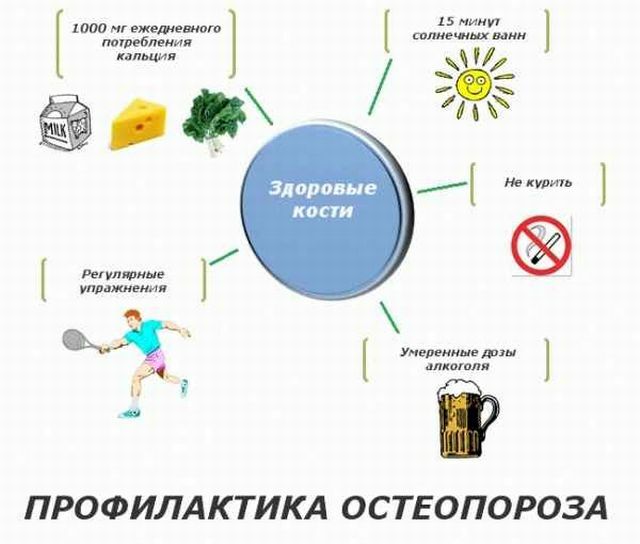
Prevention of osteoporosis is a mandatory option in the
medical care complex. In the absence of treatment, the symptomatology may manifest itself more clearly, but the time passed and repeated therapy will become the guarantee of the normal functioning of the limbs.
When choosing a profession, it is important to exclude the possibility of intensive load on the shoulder girdle.

